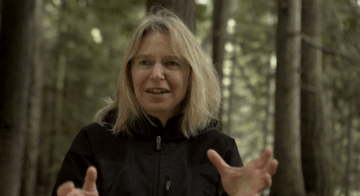Brandon Keim in Nautilus:
 Consider a forest: One notices the trunks, of course, and the canopy. If a few roots project artfully above the soil and fallen leaves, one notices those too, but with little thought for a matrix that may spread as deep and wide as the branches above. Fungi don’t register at all except for a sprinkling of mushrooms; those are regarded in isolation, rather than as the fruiting tips of a vast underground lattice intertwined with those roots. The world beneath the earth is as rich as the one above. For the past two decades, Suzanne Simard, a professor in the Department of Forest & Conservation at the University of British Columbia, has studied that unappreciated underworld. Her specialty is mycorrhizae: the symbiotic unions of fungi and root long known to help plants absorb nutrients from soil. Beginning with landmark experiments describing how carbon flowed between paper birch and Douglas fir trees, Simard found that mycorrhizae didn’t just connect trees to the earth, but to each other as well.
Consider a forest: One notices the trunks, of course, and the canopy. If a few roots project artfully above the soil and fallen leaves, one notices those too, but with little thought for a matrix that may spread as deep and wide as the branches above. Fungi don’t register at all except for a sprinkling of mushrooms; those are regarded in isolation, rather than as the fruiting tips of a vast underground lattice intertwined with those roots. The world beneath the earth is as rich as the one above. For the past two decades, Suzanne Simard, a professor in the Department of Forest & Conservation at the University of British Columbia, has studied that unappreciated underworld. Her specialty is mycorrhizae: the symbiotic unions of fungi and root long known to help plants absorb nutrients from soil. Beginning with landmark experiments describing how carbon flowed between paper birch and Douglas fir trees, Simard found that mycorrhizae didn’t just connect trees to the earth, but to each other as well.
Simard went on to show how mycorrhizae-linked trees form networks, with individuals she dubbed Mother Trees at the center of communities that are in turn linked to one another, exchanging nutrients and water in a literally pulsing web that includes not only trees but all of a forest’s life. These insights had profound implications for our understanding of forest ecology—but that was just the start.
More here.
